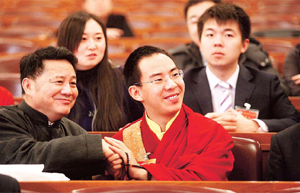Full Text: Report on central, local budgets
(Xinhua)
Updated: 2010-03-16 16:23
4. Implementation of a proactive fiscal policy
We worked hard to counter the impact of the global financial crisis; took maintaining steady and rapid economic development as the top priority of our fiscal work; made full use of the role of public finance; implemented a proactive fiscal policy; used a full range of policy tools such as budgets, government bonds, and taxes; maintained an appropriate intensity and pace of policy implementation; did all we could to boost domestic demand; ensured and improved people's wellbeing; pushed ahead with economic restructuring; and encouraged the turnaround of the economy.
We increased government investment and intensified the development of key areas. On the basis of overall plans for the use of public finance budget funds, revenue from government-managed funds, and income from the operations of state capital, the central government spent a total of 924.3 billion yuan on investment, 101.8% of the budgeted figure and an increase of 503.8 billion yuan over the budgeted figure of the previous year. This total included 256.7 billion yuan for developing agricultural infrastructure and improving rural residents' lives; 96.5 billion yuan for promoting education, health care, and other social programs; 55.1 billion yuan for building low-income housing; 77.7 billion yuan for conserving energy, reducing emissions, and improving ecosystems; 68.1 billion yuan for funding independent innovation, technological upgrading, and the service sector; 215.1 billion yuan for developing major infrastructure facilities; and 130.5 billion yuan for financing post-Wenchuan earthquake recovery and reconstruction. We strengthened the unified leadership, supervision, and inspection of central government investment to ensure it was used effectively in accordance with regulations. We issued 200 billion yuan of bonds for local governments to finance their associated expenditures. These investments increased immediate demand, stimulated non-government investment and consumer spending, and shored up weak links in economic and social development.
We optimized the taxation system and carried out structural tax reductions. We introduced VAT on consumer products across the country, adjusted the criteria for classifying small-scale VAT payers, and lowered their rate of VAT to encourage enterprises to invest more in independent innovation and technological upgrading. We carried out the reform of taxes and fees on refined oil products to make the tax burden equitable and promote energy conservation and emissions reductions. The sales tax rate for passenger vehicles with engine displacement of 1.6 liters or less was temporarily reduced to 5%. The export tax rebate rates for textiles, garments, petrochemicals, electronic information, and other products were lowered four times, and the import and export tariffs on some commodities were adjusted many times. One hundred administrative fees were either rescinded or suspended. Implementation of the existing tax reduction and exemption policies was continued. All together, these policies on tax and fee reductions and exemptions reduced the burden of businesses and individuals by about 500 billion yuan and thereby helped expand corporate investment and stimulate individual consumption.
We increased the incomes of both urban and rural residents and strengthened their consumption capacity. We further increased subsidies for farmers and significantly raised the minimum purchase prices of grain to increase farmers' incomes. We raised allowances for urban and rural recipients of subsistence allowances, enterprise retirees, and entitled groups. We implemented the policies of subsidizing the sale of home appliances and motor vehicles including motorbikes in the countryside and getting consumers to trade-in old motor vehicles and home appliances for new ones. We also constantly improved our operational methods so that government subsidies were used more effectively. Preliminary statistics show that 34.5 million home appliances were sold at subsidized prices in the countryside.


